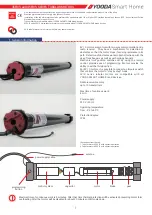
OPERATION AND MAINTENANCE MANUAL
MAC-HS MOTORS
PAGE: 19
CODE: CTT32 EDITION: 04 RELEASE: SEPTEMBER 2020
Subject to technical changes without prior notice
3.3.6
Insulation class
The insulation thermal class rating of an electrical machine is identified on the motor nameplate by means of a letter in
accordance with the IEC/EN 60034-18 international standard.
The table below summarises the maximum allowed temperature in the insulation system of a winding in accordance with its
insulation thermal class rating:
Thermal
class rating
Thermal class
A
105ºC
E
120ºC
B
130ºC
F
155ºC
H
180ºC
Table 9: Thermal classes
3.3.7
Stress category severity
The table below describes the four stress categories defined in the IEC 6034-18-41 international standard:
Stress category
Overshoot Factor (OF)
Up/Ua
Impulse Risetime
A – Benign
OF ≤ 1,1
0,3 μs
B – Moderate
1,1 < OF ≤ 1,5
C – Severe
1,5 < OF ≤ 2,0
D – Extreme
2,0 < OF ≤ 2,5
Table 10: Phase-to-ground stress categories
3.3.8
Heating limits
The IEC60034-1 international standard defines the maximum admissible heating (temperature rise) for the windings as specified
in the table below:
Thermal Class
Coolant
temperature
Heating
(per element)
Operating
temperature
B (130ºC)
< 40ºC
< 80ºC
< 120ºC
F (155ºC)
< 40ºC
< 105ºC
< 145ºC
H (180ºC)
< 40ºC
< 125ºC
< 165ºC
Table 11: Heating limits
In this regard the rated working conditions of the motor must be such that the operating temperature on the windings is always
below the temperature specified by the insulation class of its composing materials. Therefore, the working thermal class of a
motor can correspond to the following:
a)
The same thermal insulation class
. This would be the case of a motor built with
Class F
insulation (155°C) with a
maximum working temperature of 140°C, corresponding to a
Class F
.
Summary of Contents for MAC-HS 100
Page 1: ...OPERATION AND MAINTENANCE MANUAL MAC HS MOTORS...
Page 64: ...P CTT 32 ED 04...
















































